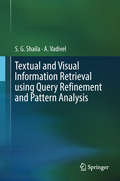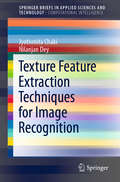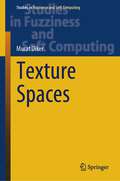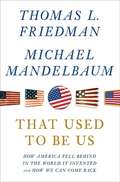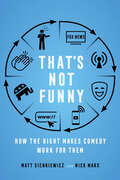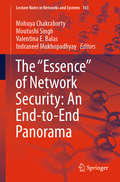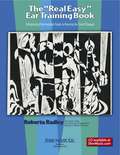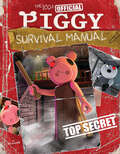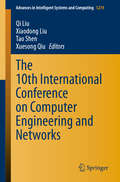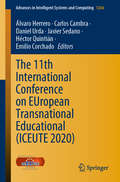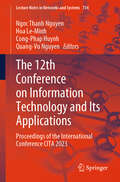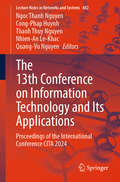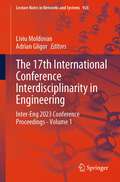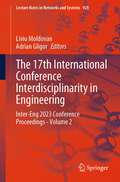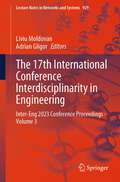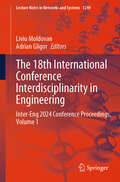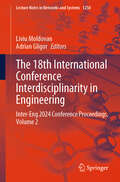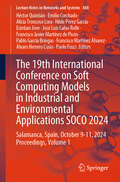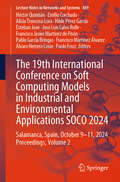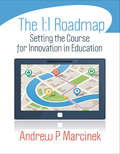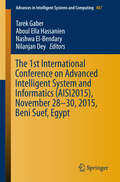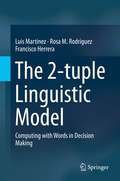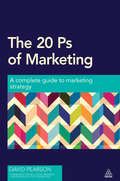- Table View
- List View
Textual and Visual Information Retrieval using Query Refinement and Pattern Analysis
by S. G. Shaila A VadivelThis book offers comprehensive coverage of information retrieval by considering both Text Based Information Retrieval (TBIR) and Content Based Image Retrieval (CBIR), together with new research topics. The approach to TBIR is based on creating a thesaurus, as well as event classification and detection. N-gram thesaurus generation for query refinement offers a new method for improving the precision of retrieval, while event classification and detection approaches aid in the classification and organization of information using web documents for domain-specific retrieval applications. In turn, with regard to content based image retrieval (CBIR) the book presents a histogram construction method, which is based on human visual perceptions of color. The book’s overarching goal is to introduce readers to new ideas in an easy-to-follow manner.
Texture Feature Extraction Techniques for Image Recognition (SpringerBriefs in Applied Sciences and Technology)
by Nilanjan Dey Jyotismita ChakiThe book describes various texture feature extraction approaches and texture analysis applications. It introduces and discusses the importance of texture features, and describes various types of texture features like statistical, structural, signal-processed and model-based. It also covers applications related to texture features, such as facial imaging. It is a valuable resource for machine vision researchers and practitioners in different application areas.
Texture Spaces (Studies in Fuzziness and Soft Computing #411)
by Murat DikerThis book provides a complete framework for the fundamental concepts and results of texture spaces and its applications. The principal aim is to present a comprehensive arguments due to connections among the textures, fuzzy sets and rough sets. In this context, direlations, fuzzy direlations and fuzzy relations constitute a bridge for the remarkable observations on rough set theory. In a more general setting, the approximation operators are also inspected for fuzzy rough set models with two domains of discourse. Since the book is self-contained and reader-friendly, the respected researchers may utilize this source for further investigations of the necessary results for their studies on rough set theory using textures. Therefore, prospective readers are not only mathematicians who interest in purely mathematical theories related to textures, but also engineers of information sciences who need more information for their interdisciplinary studies with respect to rough sets and fuzzy sets.
That Used to Be Us: How America Fell Behind in the World It Invented and How We Can Come Back
by Thomas L. Friedman Michael MandelbaumAmerica is in trouble. We face four major challenges on which our future depends, and we are failing to meet them -- and if we delay any longer, soon it will be too late for us to pass along the American dream to future generations. In That Used to Be Us, Thomas L. Friedman, one of our most influential columnists, and Michael Mandelbaum, one of our leading foreign policy thinkers, offer both a wake-up call and a call to collective action. They analyze the four challenges we face -- globalization, the revolution in information technology, the nation's chronic deficits, and our pattern of excessive energy consumption -- and spell out what we need to do now to sustain the American dream and preserve American power in the world. They explain how the end of the Cold War blinded the nation to the need to address these issues seriously, and how China's educational successes, industrial might, and technological prowess remind us of the ways in which "that used to be us. " They explain how the paralysis of our political system and the erosion of key American values have made it impossible for us to carry out the policies the country urgently needs. And yet Friedman and Mandelbaum believe that the recovery of American greatness is within reach. They show how America's history, when properly understood, offers a five-part formula for prosperity that will enable us to cope successfully with the challenges we face. They offer vivid profiles of individuals who have not lost sight of the American habits of bold thought and dramatic action. They propose a clear way out of the trap into which the country has fallen, a way that includes the rediscovery of some of our most vital traditions and the creation of a new thirdparty movement to galvanize the country. That Used to Be Us is both a searching exploration of the American condition today and a rousing manifesto for American renewal.
That's Not Funny: How the Right Makes Comedy Work for Them
by Matt SienkiewiczA rousing call for liberals and progressives to pay attention to the emergence of right-wing comedy and the political power of humor. "Why do conservatives hate comedy? Why is there no right-wing Jon Stewart?" These sorts of questions launch a million tweets, a thousand op-eds, and more than a few scholarly analyses. That's Not Funny argues that it is both an intellectual and politically strategic mistake to assume that comedy has a liberal bias. Matt Sienkiewicz and Nick Marx take readers––particularly self-described liberals––on a tour of contemporary conservative comedy and the "right-wing comedy complex." In That's Not Funny, "complex" takes on an important double meaning. On the one hand, liberals have developed a social-psychological complex—it feels difficult, even dangerous, to acknowledge that their political opposition can produce comedy. At the same time, the right has been slowly building up a comedy-industrial complex, utilizing the humorous, irony-laden media strategies of liberals such as Jon Stewart, Samantha Bee, and John Oliver to garner audiences and supporters. Right-wing comedy has been hiding in plain sight, finding its way into mainstream conservative media through figures ranging from Fox News's Greg Gutfeld to libertarian podcasters like Joe Rogan. That's Not Funny taps interviews with conservative comedians and observations of them in action to guide readers through media history, text, and technique. You will find many of these comedians utterly appalling, some surprisingly funny, and others just plain weird. They are all, however, culturally and politically relevant—the American right is attempting to seize spaces of comedy and irony previously held firmly by the left. You might not like this brand of humor, but you can't ignore it.
The "Essence" of Network Security: An End-to-End Panorama (Lecture Notes in Networks and Systems #163)
by Valentina E. Balas Mohuya Chakraborty Moutushi Singh Indraneel MukhopadhyayThis edited book provides an optimal portrayal of the principles and applications related to network security. The book is thematically divided into five segments: Part A describes the introductory issues related to network security with some concepts of cutting-edge technologies; Part B builds from there and exposes the readers to the digital, cloud and IoT forensics; Part C presents readers with blockchain and cryptography techniques; Part D deals with the role of AI and machine learning in the context of network security. And lastly, Part E is written on different security networking methodologies. This is a great book on network security, which has lucid and well-planned chapters. All the latest security technologies are thoroughly explained with upcoming research issues. Details on Internet architecture, security needs, encryption, cryptography along with the usages of machine learning and artificial intelligence for network security are presented in a single cover. The broad-ranging text/reference comprehensively surveys network security concepts, methods, and practices and covers network security policies and goals in an integrated manner. It is an essential security resource for practitioners in networks and professionals who develop and maintain secure computer networks.
The "Real Easy" Ear Training Book
by Sher Music Roberta RadleyAll great musicians have one thing in common---to a great extent they know what the harmony of a song is as they hear it. Do you? If not, here is a practical guide to get you up to speed. Written by Berklee professor Roberta Radley, it uses contemporary music to help you see how ear training is invaluable for your own musical needs.
The 100% Official Piggy Survival Manual: An AFK Book
by ScholasticFans will not want to miss the very first official guide to PIGGY! Full of tips, tricks, lore, and more, this guide has everything you need to survive!Make it out alive with the official Piggy Survival Manual! This handbook includes everything you need to survive in the terror-filled world of PIGGY! Uncover secrets, master every book and chapter, and learn all there is to know about the world and characters of PIGGY.
The 10th International Conference on Computer Engineering and Networks (Advances in Intelligent Systems and Computing #1274)
by Xuesong Qiu Qi Liu Xiaodong Liu Tao ShenThis book contains a collection of the papers accepted by the CENet2020 – the 10th International Conference on Computer Engineering and Networks held on October 16-18, 2020 in Xi’an, China. The topics focus but are not limited to Internet of Things and Smart Systems, Artificial Intelligence and Applications, Communication System Detection, Analysis and Application, and Medical Engineering and Information Systems. Each part can be used as an excellent reference by industry practitioners, university faculties, research fellows and undergraduates as well as graduate students who need to build a knowledge base of the most current advances and state-of-practice in the topics covered by this conference proceedings. This will enable them to produce, maintain, and manage systems with high levels of trustworthiness and complexity.
The 11th International Conference on EUropean Transnational Educational (Advances in Intelligent Systems and Computing #1266)
by Álvaro Herrero Javier Sedano Héctor Quintián Emilio Corchado Daniel Urda Carlos CambraThis book contains accepted papers presented at ICEUTE 2020 held in the beautiful and historic city of Burgos (Spain), in September 2020.The 11th International Conference on EUropean Transnational Education (ICEUTE 2020) has been a meeting point for people working on transnational education within Europe. It has provided a stimulating and fruitful forum for presenting and discussing the latest works and advances on transnational education within European countries.After a thorough peer-review process, the ICEUTE 2020 International Program Committee selected 44 papers which are published in these conference proceedings achieving an acceptance rate of 41%. Due to the COVID-19 outbreak, the ICEUTE 2020 edition was blended, combining on-site and on-line participation. In this relevant edition, a special emphasis was put on the organization of five special sessions related to relevant topics as Role of English in Transnational Education and Teacher Training, Personalization and ICT: a Path to Educational Inclusion, Innovation and Research Findings in Engineering Higher Education, Practical Implementations of Novel Initiatives, and Innovation in Computer Science Higher Education.The selection of papers was extremely rigorous in order to maintain the high quality of the conference, and we would like to thank the members of the Program Committees for their hard work in the reviewing process. This is a crucial process to the creation of a high standard conference, and the ICEUTE conference would not exist without their help.
The 12th Conference on Information Technology and Its Applications: Proceedings of the International Conference CITA 2023 (Lecture Notes in Networks and Systems #734)
by Ngoc Thanh Nguyen Hoa Le-Minh Cong-Phap Huynh Quang-Vu NguyenThis book constitutes the refereed proceedings of the 12th Conference on Information Technology and its Applications, CITA 2023, taking place on July 28-29, 2023 in Da Nang City, the most beautiful and livable city in Vietnam. CITA is an annual scientific conference on information technology and its applications in all fields. The main objective of the conference is to create a forum to gather and connect Vietnamese and international researchers, scientists in the fields of information technology and its applications. The book includes 33 papers, selected from 144 papers submitted to CITA 2023 whose authors come from over 20 countries around the world, which were carefully reviewed by at least two members of the Program Committee, with professional advice from reputable scientists in the field of information technology and technology, digital economy such as Prof. Dr.Sc. Ngoc-Thanh Nguyen (Poland), Prof. Dr. Dosam Hwang (Korea), Assoc. Prof. Dr. Le Minh Hoa (UK), and Prof.Dr. Nguyen Thanh Thuy (Vietnam). The acceptance rate of CITA 2023 is about 24%. The papers in the book are organized in the following topical sections: Data Science and Artificial Intelligence; Image and Natural Language Processing; Software Engineering and Information Systems; Network and Communications; and Digital Economy. The accepted and presented papers focus on new trends and challenges facing the information and communication technology as well as digital economy community. If you are scientists, lecturers, doctoral students, we hope that you will find many useful and good quality results from the book for your future research.
The 13th Conference on Information Technology and Its Applications: Proceedings of the International Conference CITA 2024 (Lecture Notes in Networks and Systems #882)
by Ngoc Thanh Nguyen Nhien-An Le-Khac Cong-Phap Huynh Quang-Vu Nguyen Thanh Thuy NguyenThis book presents selected papers from the 13th International Conference on Information Technology and its Applications (CITA 2024) which took place on July 19–20, 2024. The 13th CITA will be hosted by the Vietnam-Korea University of Information and Communication Technology (VKU), a member of University of Danang, with the supports of the researching and training institutions belonging to ASEAN Consortium for Innovation and Research (ACIR) as well as Vietnam ICT Association of Faculties-Institutes-School-Universities (FISU Vietnam). The conference will take place in Da Nang City and Hoi An City which are beautiful and livable cities in Vietnam. All papers submitted to CITA 2024 are reviewed seriously, closely, and thoroughly by 02-04 reviewers with appropriate expertise, with professional advice from reputable scientists in the fields of information and communication technology. Over the past 13 years of establishment and development, CITA has become an international scientific conference with a prestigious brand in the scientific community not only in Vietnam but also around the world in the field of ICT and digital economy. For this edition of the conference, we have received in total 173 papers whose authors come from over 25 countries around the world. Only 43 papers of the highest quality were selected for oral presentation and publication in this LNNS volume. The average rate of papers accepted by this volume is about 25%. Papers included in these proceedings cover the following topics: data science and artificial intelligence, image and natural language processing, software engineering and information system, network and communications, and digital economy. The accepted and presented papers focus on new trends and challenges facing information technology and its applications. The presenters show how research works can stimulate novel and innovative applications. We hope that you find these results useful and inspiring for your future research work.
The 17th International Conference Interdisciplinarity in Engineering: Inter-Eng 2023 Conference Proceedings - Volume 1 (Lecture Notes in Networks and Systems #926)
by Liviu Moldovan Adrian GligorThis book contains research papers that were accepted for presentation at the 17th International Conference on Interdisciplinarity in Engineering—INTER-ENG 2023, which was held on 5–6 October 2023, in the city of Târgu Mureș, Romania. The general scope of the conference “Towards transition for a more competitive European industry in a smart, safe and sustainable future” is proposing a new approach related to the development of a new generation of smart factories grounded on the manufacturing and assembly process digitalization. It is related to advance manufacturing technology, lean manufacturing, sustainable manufacturing, additive manufacturing, manufacturing tools and equipment. It is a leading international professional and scientific forum of great interest for engineers and scientists who can read in this book research works contributions and recent developments as well as current practices in advanced fields of engineering.
The 17th International Conference Interdisciplinarity in Engineering: Inter-Eng 2023 Conference Proceedings - Volume 2 (Lecture Notes in Networks and Systems #928)
by Liviu Moldovan Adrian GligorThis book contains research papers that were accepted for presentation at the 17th International Conference on Interdisciplinarity in Engineering—INTER-ENG 2023, which was held on 5–6 October 2023, in the city of Târgu Mureș, Romania. The general scope of the conference “Towards transition for a more competitive European industry in a smart, safe and sustainable future” is proposing a new approach related to the development of a new generation of smart factories grounded on the manufacturing and assembly process digitalization. It is related to advance manufacturing technology, lean manufacturing, sustainable manufacturing, additive manufacturing, manufacturing tools and equipment. It is a leading international professional and scientific forum of great interest for engineers and scientists who can read in this book research works contributions and recent developments as well as current practices in advanced fields of engineering.
The 17th International Conference Interdisciplinarity in Engineering: Inter-Eng 2023 Conference Proceedings - Volume 3 (Lecture Notes in Networks and Systems #929)
by Liviu Moldovan Adrian GligorThis book contains research papers that were accepted for presentation at the 17th International Conference on Interdisciplinarity in Engineering—INTER-ENG 2023, which was held on 5–6 October 2023, in the city of Târgu Mureș, Romania. The general scope of the conference “Towards transition for a more competitive European industry in a smart, safe and sustainable future” is proposing a new approach related to the development of a new generation of smart factories grounded on the manufacturing and assembly process digitalization. It is related to advance manufacturing technology, lean manufacturing, sustainable manufacturing, additive manufacturing, manufacturing tools and equipment. It is a leading international professional and scientific forum of great interest for engineers and scientists who can read in this book research works contributions and recent developments as well as current practices in advanced fields of engineering.
The 18th International Conference Interdisciplinarity in Engineering: Inter-Eng 2024 Conference Proceedings, Volume 1 (Lecture Notes in Networks and Systems #1249)
by Liviu Moldovan Adrian GligorThis book contains research papers that were accepted for presentation at the 18th International Conference on Interdisciplinarity in Engineering—INTER-ENG 2024, which was held on 3–4 October 2024, in the city of Targu Mures, Romania. The general scope of the conference “An effective digital-green transition for a more competitive European industry” is proposing a new approach related to the development of a new generation of smart factories grounded on the manufacturing and assembly process digitalization. It is related to advance manufacturing technology, lean manufacturing, sustainable manufacturing, additive manufacturing, manufacturing tools and equipment. It is a leading international professional and scientific forum of great interest for engineers and scientists who can read in this book research works contributions and recent developments as well as current practices in advanced fields of engineering.
The 18th International Conference Interdisciplinarity in Engineering: Inter-Eng 2024 Conference Proceedings, Volume 2 (Lecture Notes in Networks and Systems #1250)
by Liviu Moldovan Adrian GligorThis book contains research papers that were accepted for presentation at the 18th International Conference on Interdisciplinarity in Engineering—INTER-ENG 2024, which was held on 3–4 October 2024, in the city of Targu Mures, Romania. The general scope of the conference “An effective digital-green transition for a more competitive European industry” is proposing a new approach related to the development of a new generation of smart factories grounded on the manufacturing and assembly process digitalization. It is related to advance manufacturing technology, lean manufacturing, sustainable manufacturing, additive manufacturing, manufacturing tools and equipment. It is a leading international professional and scientific forum of great interest for engineers and scientists who can read in this book research works contributions and recent developments as well as current practices in advanced fields of engineering.
The 19th International Conference on Soft Computing Models in Industrial and Environmental Applications SOCO 2024: Salamanca, Spain, October 9-11, 2024 Proceedings, Volume 1 (Lecture Notes in Networks and Systems #888)
by Héctor Quintián Emilio Corchado Francisco Javier Martínez de Pisón Hilde Pérez García Francisco Martínez Álvarez Alicia Troncoso Lora Pablo García Bringas Esteban Jove José Luis Calvo Rolle Paolo Fosci Álvaro Herrero CosíoThis volume of Advances in Intelligent and Soft Computing contains accepted papers presented at the SOCO 2024 conference held in the beautiful and historic city of Salamanca (Spain) in October 2024. Soft computing represents a collection or set of computational techniques in machine learning, computer science, and some engineering disciplines that investigate, simulate, and analyze very complex issues and phenomena. After a thorough peer-review process, the 18th SOCO 2023 International Program Committee selected 62 papers for publication in these conference proceedings, representing an acceptance rate of 50%. In this relevant edition, a particular emphasis was put on organizing special sessions. Four special sessions were organized related to relevant topics such as Machine Learning and Computer Vision in Industry 4.0, Intelligent Models and Frameworks for Smart Agriculture and Green Economy, Computational Intelligence Applied to Modelling and Control of Engineering Systems, and Applied Machine Learning (2nd Edition). The selection of papers was extremely rigorous to maintain the high quality of the conference. We want to thank the members of the Program Committees for their hard work during the reviewing process. This is a crucial process for creating a high-standard conference; the SOCO conference would not exist without their help.
The 19th International Conference on Soft Computing Models in Industrial and Environmental Applications SOCO 2024: Salamanca, Spain, October 9-11, 2024 Proceedings, Volume 2 (Lecture Notes in Networks and Systems #889)
by Héctor Quintián Emilio Corchado Francisco Javier Martínez de Pisón Hilde Pérez García Francisco Martínez Álvarez Alicia Troncoso Lora Pablo García Bringas Esteban Jove José Luis Calvo Rolle Paolo Fosci Álvaro Herrero CosíoThis volume of Advances in Intelligent and Soft Computing contains accepted papers presented at the SOCO 2024 conference held in the beautiful and historic city of Salamanca (Spain) in October 2024. Soft computing represents a collection or set of computational techniques in machine learning, computer science, and some engineering disciplines that investigate, simulate, and analyze very complex issues and phenomena. After a thorough peer-review process, the 18th SOCO 2023 International Program Committee selected 62 papers for publication in these conference proceedings, representing an acceptance rate of 50%. In this relevant edition, a particular emphasis was put on organizing special sessions. Four special sessions were organized related to relevant topics such as Machine Learning and Computer Vision in Industry 4.0, Intelligent Models and Frameworks for Smart Agriculture and Green Economy, Computational Intelligence Applied to Modelling and Control of Engineering Systems, and Applied Machine Learning (2nd Edition). The selection of papers was extremely rigorous to maintain the high quality of the conference. We want to thank the members of the Program Committees for their hard work during the reviewing process. This is a crucial process for creating a high-standard conference; the SOCO conference would not exist without their help.
The 1: Setting the Course for Innovation in Education
by Andrew P. MarcinekTechnology is more than just “Computer Class;” it is a literacy that must be threaded throughout the fabric of a school. In a 1:1 environment, you’re preparing students to be responsible citizens of the physical and digital worlds. But it’s easy to get overwhelmed with devices; you have to have a plan for technology that keeps learning at center stage. Here you’ll find a solid plan for designing a technology initiative that fuels student learning. Real-life examples, lessons, and interviews with stakeholders show you Why a 1:1 program is not only achievable but also beneficial and necessary How to choose the right devices The best ways to prepare teachers through professional development Best practices for instruction and personalization in a 1:1 environment It’s more essential than ever to integrate digital and information literacy into the fabric of our schools. This practical resource will get you started on the journey.
The 1: Setting the Course for Innovation in Education
by Andrew P. MarcinekTechnology is more than just “Computer Class;” it is a literacy that must be threaded throughout the fabric of a school. In a 1:1 environment, you’re preparing students to be responsible citizens of the physical and digital worlds. But it’s easy to get overwhelmed with devices; you have to have a plan for technology that keeps learning at center stage. Here you’ll find a solid plan for designing a technology initiative that fuels student learning. Real-life examples, lessons, and interviews with stakeholders show you Why a 1:1 program is not only achievable but also beneficial and necessary How to choose the right devices The best ways to prepare teachers through professional development Best practices for instruction and personalization in a 1:1 environment It’s more essential than ever to integrate digital and information literacy into the fabric of our schools. This practical resource will get you started on the journey.
The 1st International Conference on Advanced Intelligent System and Informatics (AISI2015), November 28-30, 2015, Beni Suef, Egypt
by Aboul Ella Hassanien Tarek Gaber Nashwa El-Bendary Nilanjan DeyThe conference topics address different theoretical and practicalaspects, and implementing solutions for intelligent systems and informaticsdisciplines including bioinformatics, computer science, medical informatics,biology, social studies, as well as robotics research. The conference alsodiscuss and present solutions to the cloud computing and big data miningwhich are considered hot research topics. The conference papers discusseddifferent topics - techniques, models, methods, architectures, as well as multiaspect, domain-specific, and new solutions for the above disciplines. Theaccepted papers have been grouped into five parts: Part I--Intelligent Systems and Informatics, addressing topics including,but not limited to, medical application, predicting student performance, actionclassification, and detection of dead stained microscopic cells, opticalcharacter recognition, plant identification, rehabilitation of disabled people. Part II--Hybrid Intelligent Systems, addressing topics including, but notlimited to, EMG signals, text classification, geomagnetic inverse problem,email filtering. Part III--Multimedia Computing and Social Networks, addressing topics including,but not limited to, augmented reality, telepresence robot, video flash matting,community detection, quality images, face thermal image extraction, MRI tumorsegmentation. Part V--Cloud Computing and Big Data Mining, discussing topics including,but not limited to, mining on microblogs, query optimization, big dataclassification, access control, friendsourcing, and assistive technology. Part VI--Swarm Optimization and Its Applications, addressing topicsincluding, but not limited to, solving set covering problem, adaptive PSO forCT liver segmentation, water quality assessment, attribute reduction, fish detection,solving manufacturing cell design problem.
The 2-tuple Linguistic Model
by Francisco Herrera Luis Martínez Rosa M. RodriguezThis book examines one of the more common and wide-spread methodologies to deal with uncertainty in real-world decision making problems, the computing with words paradigm, and the fuzzy linguistic approach. The 2-tuple linguistic model is the most popular methodology for computing with words (CWW), because it improves the accuracy of the linguistic computations and keeps the interpretability of the results. The authors provide a thorough review of the specialized literature in CWW and highlight the rapid growth and applicability of the 2-tuple linguistic model. They explore the foundations and methodologies for CWW in complex frameworks and extensions. The book introduces the software FLINTSTONES that provides tools for solving linguistic decision problems based on the 2-tuple linguistic model. Professionals and researchers working in the field of classification or fuzzy sets and systems will find The 2-tuple Linguistic Model: Computing with Words in Decision Making a valuable resource. Undergraduate and postdoctoral students studying computer science and statistics will also find this book a useful study guide.
The 20 Ps of Marketing
by David PearsonMarketing has changed dramatically since the four classic Ps of the marketing mix (price, product, promotion and place) were proposed. The new marketing landscape is characterised by the demand for constant innovation, rising pressure on budgets, the growth of social media and the impact of issues of sustainability and ethical issues. As the business landscape has transformed so have the fundamental areas marketers need to master to succeed.The 20 Ps of Marketing provides a thorough guide to marketers at all levels of the new elements of the marketing mix they need to contend with for business success including: planning; persuasion; publicity; positioning; productivity; partnerships; passion and more. Combining practical advice with case studies it covers brands that have changed the game through mastery of the 20 Ps such as H agen Daz and Sony, and others, such as Kodak, who got left behind.This essential guide to the current face of marketing strategy provides marketers with a thorough and valuable grounding to the new fundamentals of marketing.
The 2013 Legal Technology Guide Solo and Small Firm
by Sharon D. Nelson John W. Simek Michael C. MaschkeThis annual guide is the only one of its kind written to help solo and small firm lawyers find the best technology for their dollar. You'll find the most current information and recommendations on computers, servers, networking equipment, legal software, printers, security products, smartphones, the iPad and anything else a law office might need. It's written in clear, easily understandable language to make implementation easier if you choose to do it yourself, or you can use it in conjunction with your IT consultant. Either way, you'll learn how to make technology work for you
